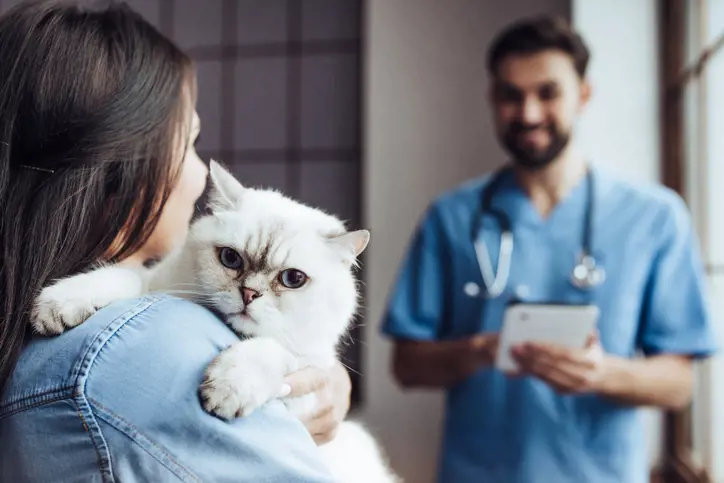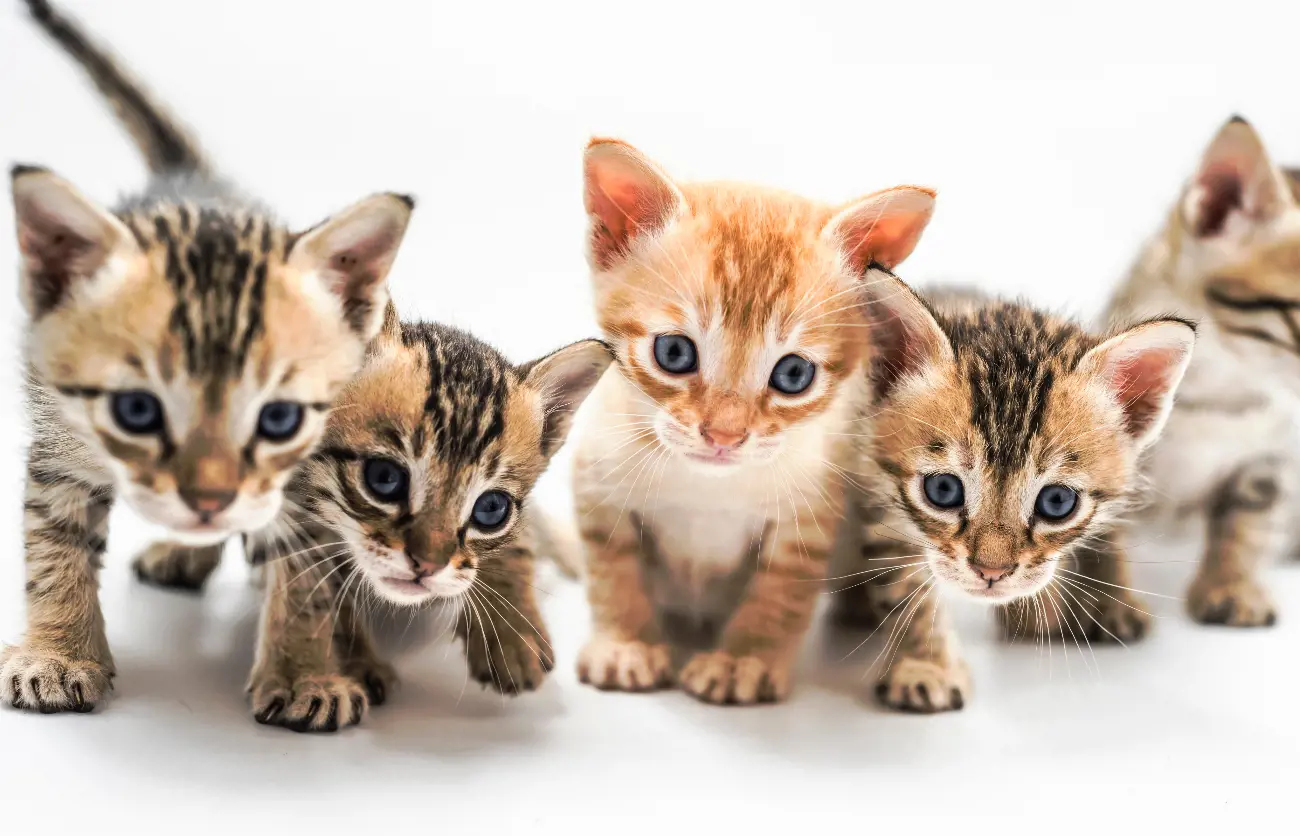How to spot cancer in cats
9th March, 2021

Hearing that your cat has cancer can be a very upsetting experience. But, just as in humans, the earlier you can identify it, the better their chances of survival and living a normal, happy life.
As a responsible pet parent, it’s your job to learn as much as you can about your pet’s health and inspect them regularly to see if there have been any changes to their normal appearance or behaviour.
As we’ll find out in this article, there are many ways in which cats can develop cancer. There are also different types of cancer and different treatments, many of which could be covered by your cat insurance if you have it.
Although cancer commonly develops with age, that’s not always the case. That’s why it’s so essential that you protect your cat at the earliest age possible. Here at Purely Pets, we can offer 15 levels of lifetime cover so you can be confident your cat will get the treatment it needs, no matter what its life stage.
So let’s learn a bit more about cancer in cats – it’s a horrible subject but after all, forewarned is forearmed.
What is cancer in cats and what causes it?
Cancer happens when the normal cell turnover process is interrupted or changed by a mutation in a cell’s DNA. Tumours are formed when new cells are produced that the body doesn’t need or when old cells don’t die as they should.
Cats are at risk of a number of different types of cancers that affect different parts of their body. These can include lymphoma (cancer of the white blood cells); leukaemia (cancer of the bone marrow); breast cancer (cancer of the mammary gland); squamous cell carcinoma (cancer of the skin); soft tissue sarcoma (cancer that affects the skin, tissues and nerves).
As the Animal Cancer Trust explains, there are a number of reasons why cancer might start in your cat’s body. These include:
-
Infection from viruses – like the feline immunodeficiency virus (FIV) or feline leukaemia virus (FeLV)
-
Lack of physical activity
-
Age
-
Exposure to sunlight (ultraviolet radiation) – especially white cats
-
Exposure to certain chemicals
-
Poor diet
-
Obesity
-
Family history of cancer
-
Female cats not being spayed
It’s important to remember that, just because there might be a family history of cancer in your cat’s line, that doesn’t mean your pet will definitely get it. But by knowing everything you can about where a cat comes from and how healthy its parents were, you’ll be better prepared to deal with any health issues in the future. Your cat insurance can help cover the costs of expensive veterinary treatment.
What are the different types of cancer in cats?
As the Blue Cross explains, the most common types of cancer found in cats affect their white blood cells, their breast or their skin, as described above.
A new study from the Royal Veterinary College (RVC) at the University of London found that cancer of the white blood cells – otherwise known as lymphoma – is more commonly found in older male cats.
It found that around one in every 2,000 cats under first opinion veterinary care were affected by lymphoma – that’s around 48 per 100,000.
The key findings from the study were:
-
Male cats are 1.7 times more likely to get lymphoma than female cats. This can be a key deciding factor in whether you would want to adopt a female or male cat.
-
Cats who are over 11 years of age are five times more likely to get lymphoma than cats aged between two and five years old.
-
Vaccinated cats were at less risk of being diagnosed with lymphoma compared to unvaccinated cats.
Interestingly, insured cats were over three times more likely to be diagnosed with lymphoma than uninsured cats. That just goes to show, insured pet owners don’t have to delay in seeking early diagnosis for their cats and getting them the care they deserve.
Although the study concluded that the breed of cat didn’t seem to affect whether the animal developed blood cancer or not, there are certain breeds that need to be more careful when it comes to sun exposure than others, as this can trigger different types of cancers.
White-faced cats are particularly prone to getting sunburn on their lips, eyelids and delicate little noses because those areas are relatively hairless and get more sun exposure than the rest of their skin.
If this strong sun exposure continues over a long period of time, the Animal Cancer Trust says some cats could develop squamous cell carcinoma (skin cancer).
How can you tell if your cat’s got cancer?
Cats are experts at hiding if they’re hurt or in pain. That’s why it’s so important to pay attention to your feline and note down any on-going changes in their eating habits, mood, behaviour or levels of physical activity.
Are they going out as much as they used to? Are they sleeping way more than usual? Are they rejecting food or being unusually aggressive when you try to stroke them? All these things could be signs your feline is suffering and in need of help.
As Purina suggests, many of the symptoms that cats develop when they have cancer are the same as when they have other non-cancerous conditions, so it’s essential that you get advice from a professional to rule out other problems. It might not be as serious as you first think.
Some of these symptoms can include:
-
Not eating and problems with chewing; bad breath
-
Increased drinking
-
Losing weight
-
Being sick or having diarrhoea
-
Limping or stiffness when walking
-
Laboured breathing or lack of stamina
-
Sores that don’t seem to heal
-
Bleeding or discharge
-
New lumps, bumps or lesions
If you find a new lump or bump on your cat – whether it’s on their tummy, back, ear or wherever – don’t panic. Chances are that it will be a benign (non-cancerous) lump that’s just an overgrowth of harmless cells. However, some lumps can be malignant (cancerous). Cancerous lumps usually spread more quickly or grow more quickly than benign lumps.
Sometimes you won’t be able to spot the jump at all, as it may be deep inside the animal. That’s why regular vet check-ups are so important. If you’re a Purely Pets policyholder, you can also call our 24-Hour Vet Helpline if you need advice.
Diagnosing cancer in cats can be very difficult and any vet will want to conduct thorough tests before confirming what’s wrong.
Sometimes the vet might decide not to operate on a lump. This is usually the case if tests reveal it’s benign and not causing the cat any other problems. If the vet suspects cancer, other tests might be conducted. These might include biopsies, x-rays, MRIs and ultrasounds – all quite expensive methods of diagnosis.
Cat insurance can help cover the costs of these kinds of investigative procedures – the quicker you get a firm diagnosis, the quicker you’ll be able to start treatment.
Questions to ask before treatment begins
Treatment for cancer in cats can be quite disruptive and stressful for the animal. Before any lengthy treatments start you might want to ask your vet the following questions:
-
What’s the prognosis without treatment?
-
Do you think the cancer is likely to spread or come back after this treatment?
-
What are my options in terms of treatments and what are the risks?
-
Will my cat fully recover and have a normal life after treatment? If not, how might their life be affected? Will I have to make changes at home?
-
How should I get my cat ready for surgery?
-
What changes might I see in my cat after treatment?
-
What’s my cat’s life expectancy after treatment?
If you do decide to proceed with treatment, your cat insurance policy with Purely Pets will tell you exactly what’s covered.
How do you treat cancer in cats?
When it comes to treating cancer in cats, there are three main ways in which this is done – through surgery, radiation therapy or chemotherapy.
Surgery will involve cutting out the offending lump or bump and may be followed up with chemotherapy or radiotherapy if required. If the cancer is still quite self-contained, surgery may cure your cat of cancer completely.
Radiotherapy involves attacking the cancer with radiation. As the Animal Cancer Trust explains, some tumours won’t react at all to this kind of treatment but others may shrink or disappear altogether.
Chemotherapy (anti-cancer drug therapy in cats) is usually used as a palliative care in animals rather than a way of beating the disease completely. But in some cases, chemotherapy can give the pet a boost and a better quality of life for the time it’s got left, so it may be worth considering.
It’s good to know that chemotherapy has few side effects when used in animals as the doses are much lower than those used in humans. However, chemotherapy may cause a temporary loss of appetite and sickness in cats, along with a higher risk of contracting infections.
If your feline has undergone surgery to remove a cancerous lump, here are some post-op tips to bear in mind:
-
Keep any bandages as dry as possible and look for weeping or bleeding through the coverings.
-
If your cat has been given a collar to wear, make sure they keep it on day and night to stop them licking or biting at the wound site, although this could be removed for meal times if your cat is struggling to eat with it on.
-
Move the cat’s food and water closer to them so they don’t have to struggle to reach it. A cat that’s had an anaesthetic will only need something light to eat afterwards. Purina suggests chicken or fish if that’s appropriate for your pet.
If your cat has had stitches during the surgery, remember to check the wound site regularly for any swelling, weeping or redness.
It goes without saying that you shouldn’t let your cat roam outside until it has fully recovered from its operation and the vet says it’s OK to do so.
Can cats have complementary therapies to help with cancer?
Some owners may wish to pursue complementary or alternative therapies for cancer in cats to go alongside the more traditional treatment.
Whether it’s acupuncture, herbal remedies, CBD treatments or nutritional supplements make sure you check with your vet before starting any complementary therapies in case they interfere with any of your cat’s current drugs or treatments.
As pet lovers, we understand how hard it is dealing with the loss of a pet but no one wants to see their pet suffer. Your cat insurance may be able to cover the costs of treatments but if these are going to be on-going for several months or even years, you need to think carefully about your pet’s quality of life.
If your cat will still be able to live a relatively normal, happy life – for example, exploring in the garden, lying in a sunny windowsill, enjoying its food and cuddles from you – then you may decide that on-going treatment is worth pursuing.
Making the decision to say goodbye can be heartbreaking but your vet will be able to advise you when the time is right for your beloved pet.
Getting your cat the treatment it needs
To ensure you can give your cat all the treatment it needs, cat insurance is a must. Purely Pets makes it easy to find the right type of cover for your pet, with 15 levels of lifetime cover to choose from up to £15,000.
If you suspect your cat may be showing signs of cancer, you can call the 24-Hour Vet Helpline for advice, which is manned by trained veterinary professionals.
Dealing with an ill pet can be a stressful time. That’s why we make managing your policy and making claims as easy as possible.
Our Gold products have been awarded a 5* Defaqto rating in 2021, so why not get a quote so our team can provide just the right cover for you and your cat?
Get a quote for cat insurance at Purely Pets today.
Helpful Pages
Recent Posts
Pet Insurance Quote
- 98% claims paid *
- Claims paid directly to vets
- 24/7 vet video consultations
- Interest free monthly payments




